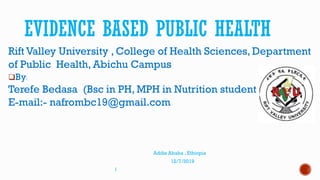
Naf ppt
- 1. EVIDENCE BASED PUBLIC HEALTH Rift Valley University , College of Health Sciences, Department of Public Health, Abichu Campus By: Terefe Bedasa (Bsc in PH, MPH in Nutrition student at RVU E-mail:- nafrombc19@gmail.com Addis Ababa , Ethiopia 12/7/2019 1
- 2. Objectives Introduction Evidence based public health steps Importance of Evidence based Public Health Sources of evidence based public health Evidence based Medicine Summary References
- 3. Objectives Explain the EBPH Understanding the characteristics of EBPH Discuss about variety of resource available for EBPH Discuss the difference between Evidence based public health and evidence base Medicine Discuss the key elements of Evidence based public health
- 4. Evidence involves “the available body of facts or information indicating whether a belief or proposition is true or valid’’. Three types of scientific evidences Type-I descriptive /epidemiology Type -II Intervention Type -III Implementation
- 5. “The conscientious, explicit, and judicious use of current best evidence in making decisions about the care of communities and populations in the domain of health protection, disease prevention, health maintenance and improvement.” (David Sackett) the care of communities and populations in the domain of health protection, disease prevention, health maintenance and improvement.”
- 6. “The development ,implementation, and evaluation of effective programs and policies in public health through application of principles of scientific reasoning, including systematic uses of data and information systems, and appropriate use of behavioral science theory and program planning models.” (Ross Bronwson) “The process of integrating science-based interventions with community preferences to improve the health of populations.” (Kohatsu ND, Robinson JG,Torner JC. EBPH 2004
- 7. The development, implementation and evaluation of effective programs and policies in public health through application of principles of scientific reasoning.
- 8. Making decisions using the best available evidence (both quantitative and qualitative research), Using data and information systems systematically, Applying program-planning frameworks (that often have a foundation in behavioral science theory), Engaging the community in assessment and decision making, Conducting sound evaluation, and Disseminating what is learned to key stakeholders and decision makers.
- 9. Despite the many achievements of public health to date, many additional challenges still remain. To meet expectations for continuous improvement for instance to achieve the MDGs a drive towards more widespread use of evidence based strategies for effectively addressing current challenges in public health is needed. Need credible filtered information to make informed decisions Research evidence is valued. • So much information, too little time!
- 10. Develop an initial statement of the issue, Quantify the issue, Search the scientific literature and organize policy information, Develop and prioritize program options, Develop an action plan and implement interventions Evaluate the program or policy
- 11. Quantify the issue Conduct literature review Develop program or policy optionDefine the issue Evaluate the program or policy Develop plan
- 12. Define the public health problem Convert the information needs into focused questions Performing a Searchable Public Health Question PICO P– Population I – Intervention C - Comparison O - Outcome
- 13. Journal literature Books Conference proceedings & abstracts Dissertations & theses Unpublished scientific papers Government reports Policy statements, laws & regulations
- 14. Surveillance data Newsletters Teleconferences & webcasts Alert systems Internet sources Expert knowledge & opinion Critically appraise the evidence
- 15. Decision for PH practices Interventions Programs Policies Expertise, Knowledge Social values, Politics, Economics $ Best Evidence from Research
- 16. Search pathway 1.Evidence based guidelines 2 Systematic Reviews 3 Pre-formulated searches 4 Best and models practices 5 Public Health journals 6 Health and data statistics 7 Legislation and policy 8 Government policy
- 17. “The integration of best research evidence with clinical expertise and patient values.” (Sackett Dl et al;churchil livingstone 2014
- 18. Convert the need for info. into an answerable question Track down the best evidence Critically appraise that evidence Integrate the appraisal with one’s clinical expertise and the individual patient Evaluate The difference between evidence based Medicine and Evidence based public health is listed below.
- 19. Prevention & health promotion Focus on populations Environment & human behavior interventions Diverse workforce, variable education & certifications Social sciences integral; clinical sciences peripheral to education Observational studies: case control & cohort studies
- 20. Focus on individuals Diagnosis & treatment Clinical interventions Well-established profession, standardized education & certification Clinical sciences integral; social sciences less emphasized Experimental studies with control groups:
- 21. EBM has transformed medicine EBM has fostered development of EBPH EBPH continues to evolve Increased community engagement
- 22. The future of the public's health in the 21st century. IOM 2002. Practice for Public Health Project University of Massachusetts Medical School 2014 Sackett Dl; EMB how practice and teach EBM, churchill livingstone 2017 Public Heath Web Portal: http://PHPartners.org
- 23. THANK YOU
